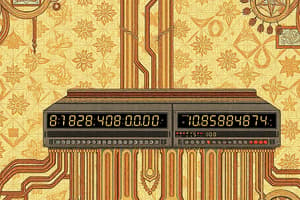Podcast
Questions and Answers
Which type of counter has flip-flops that are clocked at the same time by a common clock pulse?
Which type of counter has flip-flops that are clocked at the same time by a common clock pulse?
- Binary counter
- Synchronous counter (correct)
- Down counter
- Asynchronous counter
What controls the counting direction in an up-down counter?
What controls the counting direction in an up-down counter?
- Data inputs
- Reset signal
- Control signals UP and DOWN (correct)
- Clock pulses
Why is an asynchronous up-down counter slower than an up or down counter?
Why is an asynchronous up-down counter slower than an up or down counter?
- Due to clock pulses
- Additional propagation delay from NAND networks (correct)
- Resetting to 0's at each cycle
- Because of the control signals UP and DOWN
In a 3-bit up-down counter, what happens when UP is 1 and DOWN is 0?
In a 3-bit up-down counter, what happens when UP is 1 and DOWN is 0?
What is the essential difference between a synchronous and an asynchronous counter?
What is the essential difference between a synchronous and an asynchronous counter?
How does a synchronous binary counter differ from an asynchronous up-down counter?
How does a synchronous binary counter differ from an asynchronous up-down counter?
What is the primary purpose of a counter circuit?
What is the primary purpose of a counter circuit?
What is the distinguishing characteristic of an asynchronous counter?
What is the distinguishing characteristic of an asynchronous counter?
Which of the following statements about synchronous counters is true?
Which of the following statements about synchronous counters is true?
What determines the modulus (number of states) and sequence of states in a counter?
What determines the modulus (number of states) and sequence of states in a counter?
In the context of counters, what does the term 'modulus' refer to?
In the context of counters, what does the term 'modulus' refer to?
What is the primary advantage of using a synchronous counter over an asynchronous counter?
What is the primary advantage of using a synchronous counter over an asynchronous counter?
What is the purpose of the clock (CLK) input being applied only to the first flip-flop, FF0, in the asynchronous binary counter?
What is the purpose of the clock (CLK) input being applied only to the first flip-flop, FF0, in the asynchronous binary counter?
What is the key difference between the operation of the two flip-flops, FF0 and FF1, in the asynchronous binary counter?
What is the key difference between the operation of the two flip-flops, FF0 and FF1, in the asynchronous binary counter?
What is the reason the two flip-flops in the asynchronous binary counter are never simultaneously triggered?
What is the reason the two flip-flops in the asynchronous binary counter are never simultaneously triggered?
Which type of counter is the asynchronous binary counter shown in the text?
Which type of counter is the asynchronous binary counter shown in the text?
What is the maximum number of states in the 3-bit asynchronous binary counter described in the text?
What is the maximum number of states in the 3-bit asynchronous binary counter described in the text?
How does the operation of the 3-bit asynchronous binary counter differ from the 2-bit counter described earlier?
How does the operation of the 3-bit asynchronous binary counter differ from the 2-bit counter described earlier?
Flashcards are hidden until you start studying
Study Notes
Asynchronous Up-Down Counters
- A 3-bit up-down counter can count both up and down depending on the status of the control signals UP and DOWN.
- When UP is 1 and DOWN is 0, the counter counts up, and when UP is 0 and DOWN is 1, the counter counts down.
- The counter goes through a specific sequence as input pulses are applied, but is slower than an up counter or a down counter due to additional propagation delay.
Synchronous Counters
- A synchronous counter is one in which all the flip-flops are clocked at the same time by a common clock pulse.
- A 2-bit synchronous binary counter is an example of a synchronous counter, where the J and K inputs of the flip-flops are connected differently than in an asynchronous counter.
Uses of Counters
- Counters are used to count the number of times a certain event takes place.
- Counters are used to control a fixed sequence of actions in a digital system.
- Counters are used to generate timing signals.
- Counters are used to generate clocks of different frequencies.
Classes of Counters
- Counters are classified into two categories: asynchronous counters (ripple counters) and synchronous counters.
- Asynchronous counters are characterized by events that do not have a fixed time relationship with each other and do not occur at the same time.
- Synchronous counters are characterized by events that have a fixed time relationship with each other and do occur at the same time.
Asynchronous Counters
- An asynchronous counter is one in which the flip-flops within the counter do not change states at exactly the same time because they do not have a common clock pulse.
- A 2-bit asynchronous binary counter is an example of an asynchronous counter, where the clock is applied to the clock input of only the first flip-flop, and the second flip-flop is triggered by the output of the first flip-flop.
- The timing diagram of a 2-bit asynchronous binary counter shows the changes in the state of the flip-flop outputs in response to clock pulses.
- A 3-bit asynchronous binary counter has eight states due to its three flip-flops.
Studying That Suits You
Use AI to generate personalized quizzes and flashcards to suit your learning preferences.




